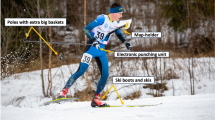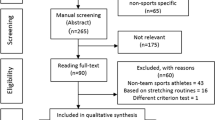Abstract
Purpose
This study aimed to analyze technical and tactical parameters characterizing the women's water polo Olympic Games (Rio, Brazil, 2016) to discriminate winning and losing performance profile in general and according to close and unbalanced games with different margin of victory (i.e., ≤ or > of 3, 4, and 5 goals of difference between teams).
Methods
Twenty-four games were analysed through the frequency of occurrence of the following technical and tactical indicators: goals scored (GS), goals scored and shots without goals inside (AsG, AsWG) and outside (5-mG, 5-mWG) the 5-m area, goals scored (5-mFG) and shots without goals (5-FWG) after a 5-m fouls, penalties scored (PS) and failed (PWG), turnovers (TO), assists (AS), blocked shots (BS), and counterattack goals (CG). Mann–Whitney U test was applied to compare the values of winning and losing teams for each indicator.
Results
Regardless of GS, no difference between teams emerged in close games. Conversely, for unbalanced games, differences between teams emerged for AS (p ≤ 0.001; effect size, ES ≥ 0.5) in each margin of victory, and for AsWG and 5-mWG (p ≤ 0.05; ES ≥ 0.3) in > 5 goals of margin of victory.
Conclusion
The outcomes of women’s water polo Olympic close and unbalanced games are determined by not specific playing events, and few technical and tactical factors (such as AS), respectively. Therefore, top-level women’s water polo coaches and physical trainers can plan a sound training session according to specific game data reported for the Olympic Games contest.

Similar content being viewed by others
References
Federation Internationale de Natation (International Swimming Federation) (2018) Water polo rules. https://www.fina.org/sites/default/files/rules-print-pdf/8476.pdf. Accessed 8 Jan 2018
Argudo Iturriaga FM, Roque JIA, Marın PG, Lara ER (2007) Influence of the efficacy values in counterattack and defensive adjustment on the condition of winner and loser in male and female water polo. Int J Perform Anal Sport 7:81–91. https://doi.org/10.1080/24748668.2007.11868398
Argudo Iturriaga FM, Ruiz E, Alonso JI (2009) Were differences in tactical efficacy between the winners and losers teams and the final classification in the 2003 water polo world championship? J Hum Sport Exerc 4:142–153. https://doi.org/10.4100/jhse
Escalante Y, Saavedra JM, Mansilla M, Tella V (2011) Discriminatory power of water polo game-related statistics at the 2008 Olympic Games. J Sports Sci 29:291–298. https://doi.org/10.1080/02640414.2010.532230
Escalante Y, Saavedra JM, Tella V, Mansilla M, García-Hermoso A, Domínguez AM (2013) Differences and discriminatory power of water polo game-related statistics in men in international championships and their relationship with the phase of the competition. J Strength Cond Res 27(4):893–901. https://doi.org/10.1519/JSC.0b013e318260ed85
Gómez MA, DelaSerna A, Lupo C, Sampaio J (2016) Effects of game location, quality of opposition and starting quarter score in the outcome of elite water polo quarters. J Strength Cond Res 30(4):1014–1020. https://doi.org/10.1097/JSC.0000000000000234
Lozovina V, Pavicic L, Lozovina M (2004) Analysis of indicators of load during the game in the activity of the center in water polo. Nase More 51:135–141
Lupo C, Capranica L, Cugliari G, Gómez MA, Tessitore A (2016) Tactical, swimming activity, and heart rate aspects of youth water polo game. J Sports Med Phys Fitness. 56(9):997–1006
Lupo C, Condello G, Capranica L, Tessitore A (2014) Women's water polo World Championships: technical and tactical aspects of winning and losing teams in close and unbalanced games. J Strength Cond Res 28(1):210–222. https://doi.org/10.1519/JSC.0b013e3182955d90
Lupo C, Condello G, Tessitore A (2012) Notational analysis of elite men’s water polo related to specific margins of victory. J Sports Sci Med 11:516–525
Lupo C, Tessitore A (2010) How important is the final outcome to interpret match analysis data: the influence of scoring a goal, and difference between close and balance games in elite soccer: comment on Lago-Penas and Gomez-Lopez (2014). Percept Mot Skills 122(1):280–285. https://doi.org/10.1177/0031512515626629
Saavedra JM, Escalante Y, Madera J, Mansilla M, García-Hermoso A (2014) Comparison of game-related statistics in men’s international championships between winning and losing teams according to margin of victory. Coll Antropol 38(3):901–907
Smith HK (2004) Penalty shot importance, success and game context in international water polo. J Sci Med Sport 7:221–225. https://doi.org/10.1016/S1440-2440(04)80012-4
Takagi H, Nishijima T, Enomoto I, Stewart AM (2005) Determining factors of game performance in the 2001 world Water Polo Championships. J Hum Mov Stud 49:333–352
Abraldes JA, Ferragut C, Rodríguez N, Vila MH (2012) Tactical and shooting variables that determine the difference between win or loss in top-level female water polo: analysis by phases of the game. Int J Perform Anal Sport 12:373–384. https://doi.org/10.1080/24748668.2011.11868567
Escalante Y, Saavedra JM, Tella V, Mansilla M, Garcia-Hermoso A, Dominguez AM (2012) Water polo game-related statistics in Women’s International Championships: differences and discriminatory power. J Sports Sci Med 11:475–482
Enomoto I, Suga M, Takahashi M, Komori T, Minami T, Fujimoto H et al (2003) A notational match analysis of the 2001 women’s water polo world championships. In: Chatard JC (ed) Biomechanics and medicine in swimming IX. University of Saint Etienne, Saint-Etienne, pp 487–492
Mirvić E, Kazazović B, Aleksandrović M (2011) Differences between winning and losing teams from world water polo championship for women. Homo Sporticus 13:41–43
Lupo C, Tessitore A, Minganti C, King B, Cortis C, Capranica L (2011) Notational analysis of American women’s collegiate water polo matches. J Strength Cond Res 25:753–757. https://doi.org/10.1519/JSC.0b013e3181cc245c
Gómez MA, DelaSerna A, Lupo C, Sampaio J (2014) Effects of Situational Variables and Starting Quarter Score in the outcome of elite women’s water polo game quarters. Int J Perform Anal Sport 14(1):73–83. https://doi.org/10.1080/24748668.2014.11868704
Huck SW (2000) Reading statistics and research, 3rd edn. Addison, Wesley Longman, New York, pp 628–629
Vila MH, Abraldes AJ, Alcaraz PE, Rodríguez N, Ferragut C (2011) Tactical and shooting variables that determine win or loss in top level in water polo. Int J Perform Anal Sport 11:486–498. https://doi.org/10.1080/24748668.2011.11868567
García-Marín P, Argudo Iturriaga FM (2017) Water polo shot indicators according to the phase of the championship: medallist versus non-medallist players. Int J Perform Anal Sport 17(4):642–655. https://doi.org/10.1080/24748668.2017.1382215
Gobbi M, D’ercole C, D’ercole A, Gobbi F (2013) The components of the jumps in expert and intermediate water polo players. J Strength Cond Res 27(10):2685–2690. https://doi.org/10.1519/JSC.0b013e318240ebf1
Platanou T (2006) Simple “in-water” vertical jump testing in water polo. Kinesiology 38:57–62
Menescardi C, Tessitore A, Estevan I, Condello G, Lupo C (2018) Analysis of shots in relation to the outcome in elite women's water polo matches. RICYDE 14(51):84–95. https://doi.org/10.5232/ricyde2018.05107
Hayley BS, Lee EB, Jared WC, Barry AS (2010) Effect of swim sprints on throwing accuracy and velocity in female collegiate water polo players. J Strength Cond Res 24(5):1195–1198. https://doi.org/10.1519/JSC.0b013e3181d82d3b
Author information
Authors and Affiliations
Corresponding author
Ethics declarations
Conflict of interest
The authors declare no conflict of interest.
Ethical approval
The study was approved by the Ethical Committee of the University of Torino (Turin, Italy; prot. 26,831) and performed in accordance with the Helsinki Declaration.
Informed consent
No informed consent due to the nature of the study.
Additional information
Publisher's Note
Springer Nature remains neutral with regard to jurisdictional claims in published maps and institutional affiliations'.
Rights and permissions
About this article
Cite this article
Mirvic, E., Rasidagic, F., Nurkovic, N. et al. Only unbalanced games are affected by technical and tactical aspects able to discriminate winning and losing performance in women’s water polo Olympic Games. Sport Sci Health 15, 427–434 (2019). https://doi.org/10.1007/s11332-019-00550-4
Received:
Accepted:
Published:
Issue Date:
DOI: https://doi.org/10.1007/s11332-019-00550-4




